Sun Tour Saguaro
This is up to a 70 mile tour that ends where it begins, so it is a one day tour for testing purposes. It involves a 1,500 foot up and down course, mostly on multi-use paths separate from traffic, and includes an 8 mile loop tour of Saguaro National Park East and a loop around Tucson. The idea is to view it as a typical day on tour and see how it goes, how far and how much time it takes. Short cuts back can make it a 50 mile tour.
Saguaro 01
September 12, 2015, one member.
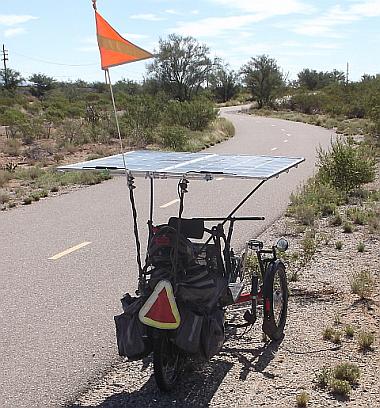 0820 Leave South Tucson via Julian Wash Path. Using level 2 assist (Falco Hx 500 hub motor with 13 ah battery) to go 10 to 12 mph slightly uphill. Had a near flat. Just refilled the tube, which had sealant, and it held so not much down time.
0820 Leave South Tucson via Julian Wash Path. Using level 2 assist (Falco Hx 500 hub motor with 13 ah battery) to go 10 to 12 mph slightly uphill. Had a near flat. Just refilled the tube, which had sealant, and it held so not much down time.
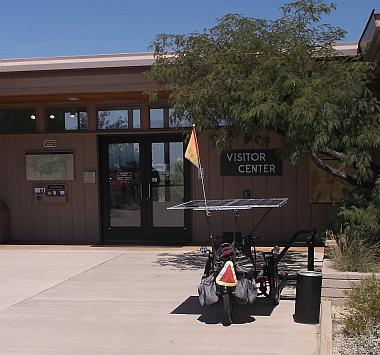 1056 Arrive, 2h 30m ride, at Rincon Mountain Visitor Center, Saguaro National Park East.
1056 Arrive, 2h 30m ride, at Rincon Mountain Visitor Center, Saguaro National Park East.
1200 Tour park via Cactus Forest Dr., a mostly one-way clockwise loop.
Ranger at gate didn't think use of assist motor allowed to qualify for $5 bicycle pass so I turned assist off, both pedelec and throttle. The Saguaro loop is 8.1 miles (13 km) with a 400 foot (122 m) climb, 2% average, but it includes very steep sections (7+%) for my human power. If using assist, I'd use level 4 or 5. The first two steep sections were short. In lowest gear, 24t chain ring to 34t sprocket, I was able to barely keep the cranks turning by putting hands on knees and helping legs push with occasional use of one arm to adjust steering. At best, I am "marginally fit" for my age.
The third section was at the end of a long uphill grade that I was able to keep the cranks spinning and go about 3 mph. 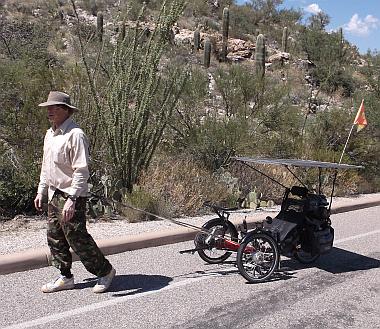 But to get up the steep section I got off, put a harness on the handlebars, and pulled the trike up. This involved no overexertion, unlike trying to pedal which was not an option at this point. At the top I just put the harness on the seat and sat on it for future use, and there was one more steep section. Of course the spandex clad had no trouble standing on the pedals to get to the top using 5-10 times more power than I possess.
But to get up the steep section I got off, put a harness on the handlebars, and pulled the trike up. This involved no overexertion, unlike trying to pedal which was not an option at this point. At the top I just put the harness on the seat and sat on it for future use, and there was one more steep section. Of course the spandex clad had no trouble standing on the pedals to get to the top using 5-10 times more power than I possess.
Using the harness and pulling was a trivial issue, however, and I've pulled the trike up a slope used by 4-wheelers to test their rig that no super athlete could conceivably ride up even on a 6K watt electric mountain bike as any single wheel would just throw dirt and dig a hole. But a 62 year old marginally fit hoofer can do it, so no complains.
1415 Back at the Visitor Center, 2h ride. I did use the motor, sort of, to slow descent on the steep downhill sections. This involves using the assist level buttons to go into a -1 to -5 level of regenerative braking which also helped recharge the battery. After over two hours of sun, the panels, with help from the regen, had fully recharged the battery. It was 53V when I left home and 50V when I arrived. After sitting in the sun for an hour the battery was 51V and back to 53V after riding the loop for 2 hours using only human power.
1435 Leave Visitor Center following Old Spanish Trail Path. My human power is fading and battery full so using level 3 assist. Parts were old and rough so I used the bike lane next to it for the smooth pavement, but mostly stayed on the path away from traffic. After some on street bike lane travel, protected from traffic by a white line, I got to the Tucson Loop (still under construction) and so had a separated-from-traffic multi-use path to go home. This tour was to check out the route and a full touring load was not carried.
1700 Sun behind a building thunderhead and no more sun today. Battery down to 50V.
1720 After 2h 45m ride, I start having difficulty pedaling hard enough to activate the motor's torque sensor, a sign that my human power is negligible. On a real Sun Tour I'd look for a place to camp. I made it 57 miles averaging 8.5 mph with more human power effort on the Saguaro loop than I'd otherwise have used but was carrying less weight, so distance traveled was in the ballpark for a first day.
1805 Arrive back home, a 70 mile tour, but last 13 miles I just used throttle to go 10 to 12 mph as left knee was complaining. The hard part was using the throttle moderately as no effort is needed to turn it up to 15 to 20 mph and suck more power from battery than would be reasonable if on an actual tour. I made it back, but battery was down to 46V which is too low to recharge in the morning before 0900, a reasonable 'let's break camp and start tour' time. Had I camped at 57 miles and 50V, battery would have been close to full if there was a morning sun. So I went 70 miles, but unless I was planning on a kickback day, I would have overused the assist. But 50 miles is far enough. Solar assist touring is all about "the power of enough," about embracing limits. Those who chaff at limits should buy a motorcycle, drive a car or RV with AC on, or fly the friendly skies and be good little hyper-consumer bots. Next test will be with a touring load.
Yes, I could have used the assist to do the Saguaro loop, but technology fails. If the assist isn't working, shouldn't be a big deal as touring without it for a time should be doable. If there is no sun I could still go 15 miles without assist, maybe 20 miles day after day. If passing through the rainy Seattle area I wouldn't expect to go farther. Less than 50 miles, but not a big deal. To go 5,000 miles in 4 to 5 months I'd need assist, but turning it off should be done periodically for no reason other than to be reminded that living without it for a few hours is thinkable. A total system failure that may take weeks to repair would be a deal breaker if touring in a group, which is why reliability is important.
The power needed, as distinct from wanted, is being defined here as whatever assist power is needed by an individual to keep up with a "very fit" but sub-athletic human. By "very fit" is meant a very fit average human which would be an "average fit bicyclist" (C class) who are probably in the upper 1% to 2% of average humans who walk the aisles of Walmart.
When I started riding the trike without assist I could go 3 to 4 miles. I rode without assist and managed a 16 mile ride after 6 months, but peak efforts are half or less of what can be sustained day to day. After riding a year with assist, which involved riding more often and for a longer period of time, I was able to go 50 miles with assist but my human power, about the same as needed to walk (30 watts), faded after 2 to 3 hours. To tour with just enough assist, as opposed to maximum assist, I want to sustain 5 hours of effort at walking level.
Human only powered cyclists are basically jogging on their bikes. Few people can jog for 5 hours and so tour under human power only. Walking 5 hours at a leisurely sustainable pace means going about 10 to 12 miles. Riding a recumbent wheelchair on mostly flat ground without assist is less taxing than walking, and is within reach of the elderly who are or would be minimally fit, whereas jogging for 5 hours would not be. Touring is like riding a tandem that only you pedal, so assist power is needed by most. Those who can't pedal at walking effort for an hour could tour with more solar assist than the 200W nominal I carried. If I fail to provide enough human power or carry a much heavier load, and as I get older I will fail, then I'll have to increase the solar assist. Thinking a bigger battery or more powerful motor is needed would be to misunderstand the issue. Those who may be able to pedal at walking effort for one hour would, In time, manage 2 hours and so on. A significant health dividend would be incurred. My goal is to manage 5 hours of walking level effort. I'm getting there. Many others could too.
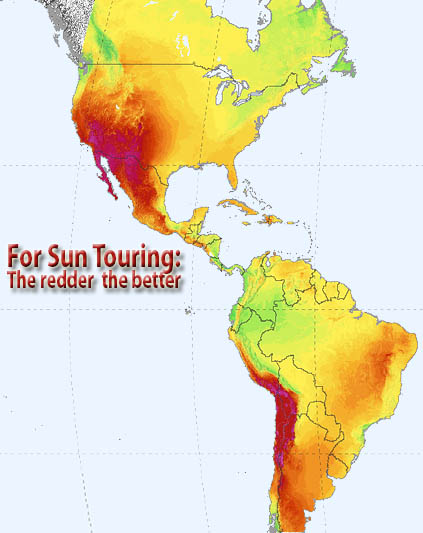
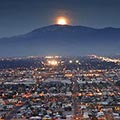
Mt. Lemmon,
May, 2016
Burning Man Lite,
August, 2016
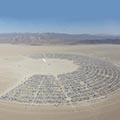
Burning Man,
August, 2016
Sun Tour America
Sponsors
Travel is fatal to prejudice, bigotry, and narrow-mindedness, and many of our people need it sorely on these accounts. Broad, wholesome, charitable views of men and things cannot be acquired by vegetating in one little corner of the earth all one's lifetime.
—Mark Twain
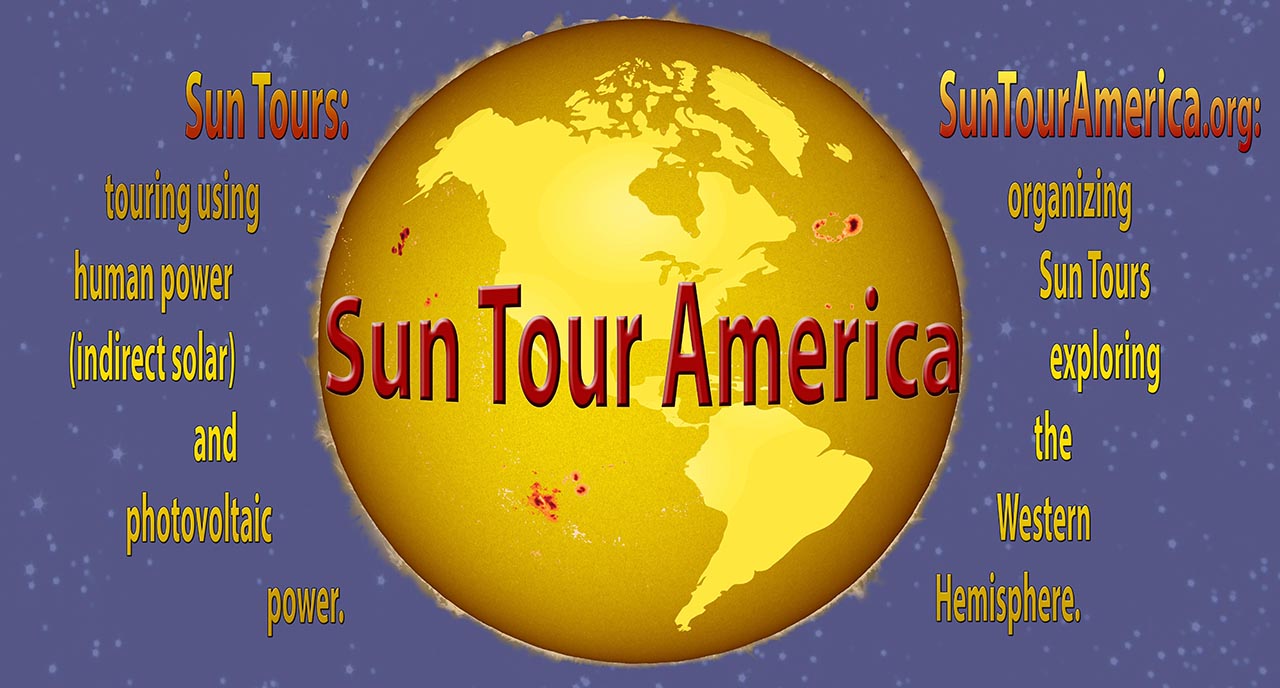
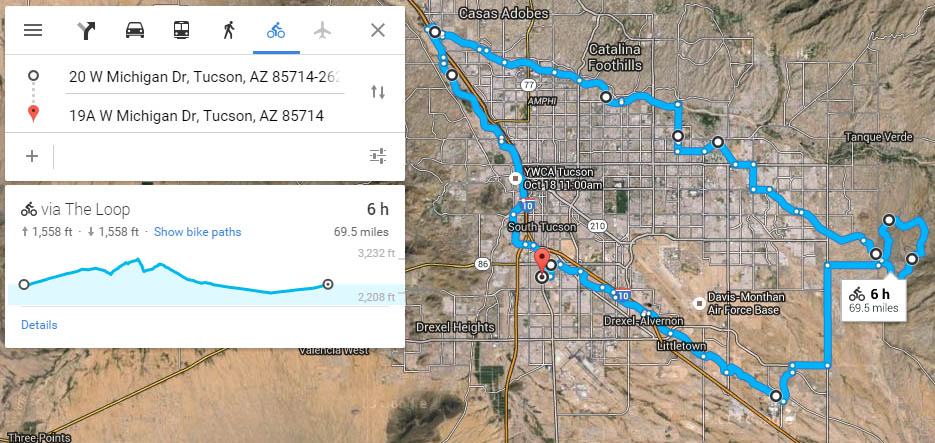
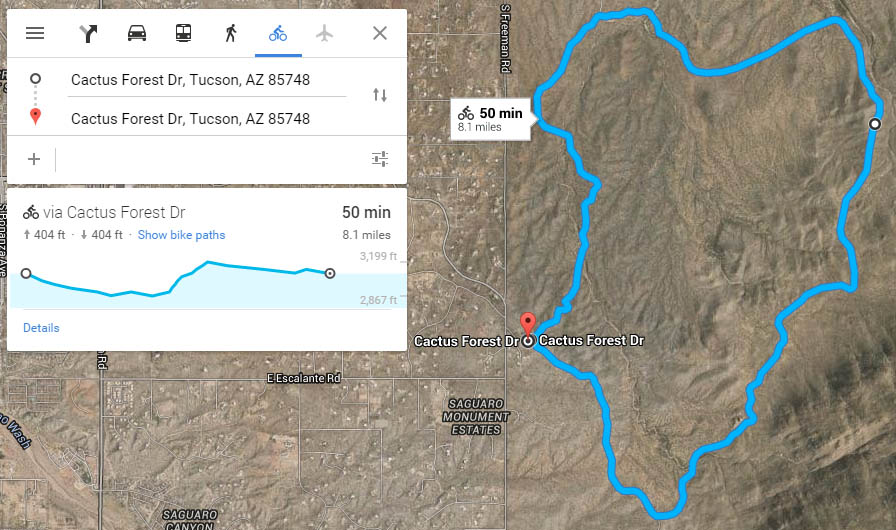


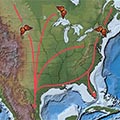
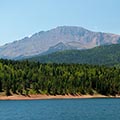
 soltechdesigns.com
soltechdesigns.com